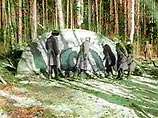During the press conference in Krasnoyarsk, Yuri Lavbin, the head of the last expedition, confirmed that parts of an extraterrestrial device had been discovered. The new expedition, organized by the Siberian Public State Foundation “Tunguska Space Phenomenon” completed its work on the scene of Tunguska meteorite fall on August 9.
The first expedition led by Professor Leonid Kulik of the Soviet Academy of Science travelled to the impact site in 1930, only 22 years after the event. However, no evidence of UFO crash was found.
Expeditions sent to the area in the 1950s and 1960s did find microscopic glass spheres in siftings of the soil. Chemical analysis showed that the spheres contained high proportions of nickel and iridium, which are found in high concentrations in meteorites, and indicated that they were of extraterrestrial origin.
Up till now, scientists believed that Tunguska event was caused by the airburst of an asteroid about 5 miles above the surface of the Earth. The asteroid is believed to have been roughly 60 meters across.
Now, researchers had traced the possible trajectory of the space object, assuming that the object had flown from West to East, unlike the previous missions who considered East to West direction. The new approach allowed the expedition members to find a buried object covered with trees.
The object appeared to be a large block made with metal. The researchers chipped a piece of the object and will now test its composition. Preliminary analyses show that it is a compound of iron silicate with unknown material.
The precise cause of the Tunguska event remains unknown. In scientific circles, the leading explanation for the blast is the impact of a meteorite. A related suggestion is that a meteorite exploded just above the Earth's surface. Whether the meteorite was of cometary or asteroidal origin is still a matter of controversy. Whatever the original cause of the event is, much of the data supports that the cause resembled a nuclear explosion.
In the absence of an obvious explanation, numerous alternative theories have been offered, such as a small black hole passing through the Earth, an impact from a piece of antimatter, and even the catastrophic destruction of a nuclear-powered alien spacecraft. However, there has not been much evidence for these exotic ideas, and simpler theories are available.
The new theory suggests that the event was a collision of a meteorite with an alien spaceship. “They exploded this enormous meteorite that headed towards us with enormous speed,” Yuri Lavbin said. Now this great object that caused the meteorite to explode is found at last. We will continue our research, he said.
Russian researchers plan another large-scale expedition to the Eastern Siberia.
FIND MORE NEWS ON TUNGUSKA EVENT
























